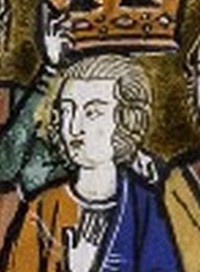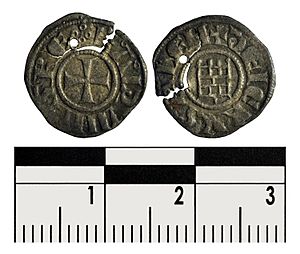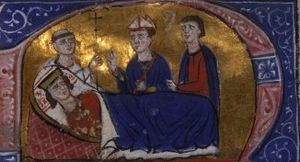Baldwin III of Jerusalem facts for kids
Quick facts for kids Baldwin III |
|
|---|---|
 |
|
| King of Jerusalem | |
| Reign | 25 December 1143 – 10 February 1163 |
| Coronation | 25 December 1143 |
| Predecessor | Melisende |
| Successor | Amalric I |
| Born | 1130 |
| Died | 10 February 1163 (aged 33) Beirut, Lebanon |
| Burial | Church of the Holy Sepulchre |
| Spouse |
Theodora Komnene
(m. 1158) |
| House | Anjou |
| Father | Fulk of Jerusalem |
| Mother | Melisende of Jerusalem |
Baldwin III (born 1130 – died February 10, 1163) was the King of Jerusalem from 1143 to 1163. He was the oldest son of Queen Melisende and King Fulk. Baldwin became king when he was still a child. At first, his mother Melisende had more power, but he later gained full control after a civil war.
During his time as king, Jerusalem became closer allies with the Byzantine Empire. The Second Crusade happened, but it failed to capture Damascus. Baldwin did manage to capture the important Egyptian fortress of Ascalon. However, he also had to deal with the growing power of Nur ad-Din in Syria. Baldwin died without children, and his brother Amalric became the next king.
Contents
Becoming King of Jerusalem
Baldwin III was born in 1130. His grandfather, King Baldwin II, was one of the first crusaders to rule Jerusalem. This meant Baldwin III was the third generation of his family to rule the kingdom.
Baldwin's mother, Princess Melisende, was the heir to her father, King Baldwin II. His father was Fulk of Anjou, a powerful count from France. King Baldwin II died when Baldwin III was just one year old. This led to a power struggle between Melisende and Fulk. Melisende insisted on her right to rule as her father's successor. She and Fulk later had another son, Amalric, who was Baldwin III's younger brother.
Baldwin III was 13 years old when his father, King Fulk, died in a hunting accident in 1143. Baldwin III was then crowned as co-ruler with his mother, Melisende. This was similar to how Melisende had been crowned with her own father. At first, Baldwin did not show much interest in running the government.
With a woman and a child ruling Jerusalem, the situation was difficult. The northern crusader states, like Tripoli, Antioch, and Edessa, started to act more independently. There was no strong king to make them follow Jerusalem's lead.
In the Muslim world, Zengi controlled northern Syria. He wanted to add Damascus to his lands. In 1144, Zengi captured Edessa. This event shocked Europe and led to the start of the Second Crusade.
The Second Crusade's Impact
The Second Crusade did not reach Jerusalem until 1148. Before that, Zengi was killed in 1146. His son, Nur ad-Din, took over and also wanted to control Damascus. To stop Nur ad-Din, Jerusalem and Damascus had formed an alliance to protect each other.
However, in 1147, Nur ad-Din and Mu'in ad-Din Unur, the governor of Damascus, made an alliance against Jerusalem. This happened because Jerusalem had broken its treaty by helping one of Unur's rebellious nobles. Baldwin marched his army from Jerusalem to attack the Muslim fortress of Bosra. But Nur ad-Din arrived with his army and forced the crusaders to retreat. As they marched back, Nur ad-Din's cavalry attacked them. However, Baldwin III's leadership and his knights' fighting skills helped them fight off the Muslim attack. Later, Jerusalem and Damascus made peace again.
In 1148, the Second Crusade finally arrived in Jerusalem. It was led by Louis VII of France, his wife Eleanor of Aquitaine, and Conrad III of Germany. Baldwin held a meeting at Acre to decide where to attack. Capturing Aleppo in the north would help get Edessa back for the Christians. But capturing Damascus in the south would limit Nur ad-Din's power and make Jerusalem stronger. Damascus was also seen as more important for Christian history.
Baldwin agreed to attack Damascus. But the siege failed after only four days. The city later fell under Nur ad-Din's control in 1154. This loss was a big problem for Jerusalem, as it meant Nur ad-Din had no strong Muslim rival in the region.
By 1149, the crusaders had gone back to Europe, leaving Jerusalem weaker. Nur ad-Din took advantage of this to invade Antioch. Prince Raymond was killed in the Battle of Inab. Baldwin III quickly went north to take charge of Antioch. Raymond's wife, Constance, was Baldwin's cousin and the rightful ruler of Antioch. Baldwin tried to arrange a marriage for her with an ally, but he was not successful.
In the north, Baldwin could not defend Turbessel, the last part of the County of Edessa. He had to give it to the Byzantine emperor Manuel I Comnenus in 1150. Baldwin helped the Latin Christian people living there to leave, even though Nur ad-Din attacked them in the Battle of Aintab. In 1152, Baldwin and his mother had to help solve a problem between Baldwin's aunt Hodierna of Tripoli and her husband Count Raymond II. After they settled the issue, Raymond was suddenly killed. Baldwin stayed to help manage things in Tripoli, while Hodierna became the temporary ruler for her young son Raymond III.
Civil War with His Mother
By 1152, Baldwin had been old enough to rule alone for seven years. He started to take more interest in running the kingdom. Even though he hadn't cared much about government before, he now wanted more power. He and his mother had grown apart since 1150. Baldwin felt that his mother's chief officer, Manasses, was stopping him from taking his rightful place as king.
In early 1152, Baldwin asked the church leader, Patriarch Fulcher, for a second coronation, separate from his mother. The patriarch refused. So, Baldwin crowned himself by parading through the city streets with laurel wreaths on his head.
Baldwin and Melisende agreed to let the Haute Cour, which was the royal council, decide the matter. The Haute Cour decided to divide the kingdom into two parts. Baldwin would rule Galilee in the north, including the cities of Acre and Tyre. Melisende would keep the richer southern parts, including Judea and Samaria, and the cities of Nablus and Jerusalem itself. Manasses and Baldwin's younger brother Amalric supported Melisende in the south. Amalric controlled the County of Jaffa in Melisende's area.
Neither Baldwin nor Melisende were happy with this decision. Baldwin wanted to rule the whole kingdom and knew that dividing it would weaken their resources. But to avoid a civil war, Melisende agreed to the plan.
However, within weeks, Baldwin invaded the south. Manasses was defeated at the castle of Mirabel and sent away. Nablus quickly fell to Baldwin. To stop more fighting, Jerusalem opened its gates to Baldwin. Melisende and Amalric sought safety in the Tower of David. During the siege, the church helped Baldwin and Melisende reach a peace agreement. Melisende was allowed to keep Nablus for the rest of her life, and Baldwin promised not to bother her. Baldwin then named his supporter, Humphrey II of Toron, as the new chief officer.
By 1154, mother and son had made up. Baldwin was smart enough to know how good his mother was at managing the kingdom. He worked to gain the support of his nobles to make the kingdom stronger. Even though she was "retired," Melisende still had a lot of influence in the court and government. She even acted as ruler for Baldwin when he was away fighting.
Strengthening the Kingdom
During the civil war, Nur ad-Din had been busy taking full control of Damascus. With Syria united under one ruler, Jerusalem could only expand its power south, towards Egypt. Egypt was also weakened by its own civil wars.
Around 1150, Baldwin rebuilt the defenses of Gaza. This put pressure on the nearby Egyptian outpost of Ascalon. In 1153, Baldwin successfully attacked and captured Ascalon. This helped secure the border with Egypt. Ascalon was added to Amalric's land, creating the double County of Jaffa and Ascalon. In 1152, Baldwin also defeated an invasion from northern Syria.
In 1156, Baldwin had to sign a peace treaty with Nur ad-Din. However, in the winter of 1157–1158, Baldwin led an army into Syria. He tried to capture Shaizar. But the attack failed because of a disagreement between Thierry, Count of Flanders and Raynald of Châtillon, who was the new husband of Constance of Antioch. Both wanted Shaizar for themselves. However, Baldwin was able to capture Harim, which used to belong to Antioch. In 1158, he also defeated Nur ad-Din in battle.
Alliance with the Byzantine Empire
Baldwin's successes helped him gain enough respect to find a wife from the powerful Byzantine Empire. In 1157, he sent Humphrey of Toron to talk with Emperor Manuel. They decided that Baldwin should marry Theodora, who was Manuel's niece.
This alliance was more helpful to the Byzantine Empire than to Jerusalem. Baldwin had to agree that Antioch was under Byzantine control. Also, if Theodora became a widow, she would be given the city of Acre. Theodora represented the alliance between Byzantium and Jerusalem, but she was not meant to have power outside of Acre. The marriage happened in September 1158. Baldwin was 28 years old, and Theodora was only 13.
Relations between Jerusalem and Byzantium improved. In 1159, Baldwin met with Manuel in Antioch. They became friends. Manuel even adopted Western clothes and customs and took part in a tournament against Baldwin. Manuel personally helped Baldwin when the king was thrown from his horse during the tournament.
Later in 1159, Baldwin became the temporary ruler of Antioch again, after Raynald of Châtillon was captured in battle. This upset Manuel, who thought Antioch was part of his empire. The emperor strengthened his ties to Antioch in 1160 by marrying Princess Maria, who was Baldwin's cousin. Baldwin himself had suggested Manuel marry another cousin, Melisende of Tripoli. He preferred not to see such a close relationship between Byzantium and Antioch.
Death and Legacy
Queen Melisende died in 1161. Baldwin himself died in Beirut on February 10, 1163. There were rumors that he had been poisoned in Antioch by pills given to him by his doctor. William of Tyre, a historian who knew Baldwin, wrote that "As soon as the king had taken the pills, he was seized with a fever and dysentery which developed into consumption from which he was never able to obtain relief or help."
On his way home, Baldwin stayed in Tripoli for a few months. Then he continued to Beirut, where he finally died. William of Tyre described the sadness: "For eight successive days, while the funeral procession moved from Beirut to Jerusalem, lamentation was unrestrained and grief was renewed almost hourly." Theodora, now the queen-dowager, moved to Acre. She was still only 18 years old, and she and Baldwin had no children. Baldwin was succeeded by his brother, Amalric I.
King Baldwin's Character
William of Tyre, who knew Baldwin well, wrote a detailed description of the king:
…He was taller than the average man, but his body was so well proportioned to his height that everything seemed to fit together perfectly. His face was handsome and refined, his skin was reddish, showing his natural strength…His eyes were of medium size, quite noticeable and sparkling. He had straight yellowish hair and a rather full beard on his cheeks and chin. He was a bit plump, but not as much as his brother, nor as thin as his mother…
Baldwin was well-educated, spoke well, and was very smart. Unlike his father, he had an excellent memory. He spent a lot of his free time reading history books. He also knew a lot about the kingdom's laws, which were later written down by lawyers like John of Ibelin.
He respected church property and did not make them pay too many taxes. He was friendly to everyone, no matter their social class. He "willingly offered to talk with anyone who wanted to or whom he met by chance. If someone asked to speak with him, he did not refuse." As a young man, he enjoyed games, but as an adult, he "changed for the better," as William says, and stayed loyal to Theodora. He was liked and respected by all his people. Even his enemy, Nur ad-Din, respected him. When Baldwin died, Nur ad-Din said, "the Franks have lost such a prince that the world has not now his like."
See also
 In Spanish: Balduino III de Jerusalén para niños
In Spanish: Balduino III de Jerusalén para niños



